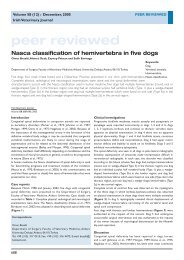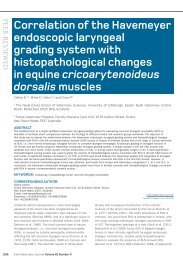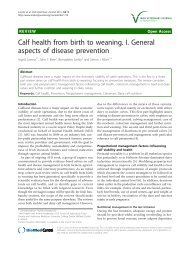peer reviewed - Irish Veterinary Journal
peer reviewed - Irish Veterinary Journal
peer reviewed - Irish Veterinary Journal
You also want an ePaper? Increase the reach of your titles
YUMPU automatically turns print PDFs into web optimized ePapers that Google loves.
Volume 57 (1) : January, 2004<br />
<strong>Irish</strong> <strong>Veterinary</strong> <strong>Journal</strong><br />
<strong>peer</strong> <strong>reviewed</strong><br />
Discussion<br />
Surgical treatment has been an important part of the proper<br />
management of chronic otitis externa, especially after medical<br />
treatment has failed and any underlying systemic disease, which<br />
could predispose to otitis externa, has been cured or controlled.<br />
LECR and VECA have been used to improve the environment<br />
within the horizontal ear canal (Grono, 1970), to permit<br />
drainage of the ear canal and to facilitate further examination,<br />
cleaning and medication of the ear canal. However, for these<br />
procedures to be successful, they must be completed before<br />
there is irreversible narrowing of the horizontal ear canal and<br />
they must be followed with continued medical treatment of the<br />
ear disease (Krahwinkel, 2003). In cases of chronic irreversible<br />
otitis externa, TECA/LBO, a salvage procedure, is considered<br />
the best treatment option (Mason et al., 1988; Beckman et al.,<br />
1990; Matthiesen and Scavelli, 1990; White and Pomeroy,<br />
1990; Devitt et al., 1997; Krahwinkel, 2003) with the principal<br />
aim of making the animal more comfortable by removing the<br />
infected tissue (Smeak and DeHoff, 1986).<br />
All dogs in this report presented with chronic otitis externa, but<br />
usually with a long duration of disease (median 12 months).<br />
LECR was undertaken in nine of the 43 dogs. The follow-up<br />
results for this group of dogs were unsatisfactory, with a<br />
complete failure of the surgery in five of eight dogs. This<br />
compares with previously reported poor responses to surgery of<br />
34.9% (Tufvesson, 1955), 47% (Gregory and Vasseur, 1983)<br />
and 55% (Sylvestre, 1998). Otitis externa is a complex disease<br />
with multiple causes, not all of which respond favourably to<br />
lateral ear canal resection (Gregory and Vasseur, 1983).<br />
Unsatisfactory results can be expected if there is an underlying<br />
otitis media present at the time of surgery (Lane and Little,<br />
1981). Otitis media can occur secondary to otitis externa and<br />
has been reported in 16% of cases of early otitis externa (Spreull,<br />
1964) and between 52% and 83% of dogs with chronic otitis<br />
externa (Spreull, 1964; Cole et al., 1998). It is important to<br />
remember that otitis media can be difficult to diagnose as it has<br />
been reported that the tympanic membrane is intact in 71% of<br />
cases with otitis media (Cole et al., 1998).<br />
An excellent result was not obtained in any dog in this series<br />
that had a concurrent dermatopathy; therefore, definitive<br />
diagnosis and appropriate treatment for the skin and ear disease<br />
is essential. TECA/LBO is indicated over LECR if owners are<br />
unable or unwilling to treat skin or ear disease appropriately<br />
(Smeak and Kerpsack, 1993). TECA/LBO is also indicated if<br />
previous surgical management (LECR, VECA, or TECA alone)<br />
of otitis externa has failed (Figure 3). Case selection for LECR<br />
is critical. Better results are expected with: early surgical<br />
intervention for correctly selected cases; appropriate diagnosis<br />
and treatment of the primary cause of the otitis externa;<br />
appropriate medical treatment of concurrent otitis media if<br />
present and commitment by owners to ongoing post-operative<br />
medical management.<br />
Once end-stage otitis externa, with or without otitis media, is<br />
diagnosed, TECA/LBO is considered the best treatment option<br />
(Mason et al., 1988; Beckman et al., 1990; Matthiesen and<br />
Scavelli, 1990; White and Pomeroy, 1990; Devitt et al, 1997;<br />
Krahwinkel, 2003; White, 2003). Total ear canal ablation alone<br />
is contraindicated due to the high risks of a concurrent otitis<br />
media (Spreull, 1964; Cole et al., 1998) leading to postoperative<br />
para-aural fistulation (Smeak and DeHoff, 1986).<br />
Combining TECA with lateral bulla osteotomy (LBO) gives<br />
access to the tympanic bulla. This allows not only the removal<br />
of any infected tissue and exudate, but also encourages growth<br />
of granulation tissue into the bulla, a result that is believed to<br />
prevent abscess formation (McAnulty et al., 1995).<br />
Of the 37 dogs in which TECA/LBO was performed, 17 dogs<br />
(46%) had generalised skin disease, a finding that compares with<br />
previously reported figures of between 64% and 80% (Mason et<br />
al., 1988; White and Pomeroy, 1990). An underlying<br />
dermatopathy is often the primary cause of the otitis externa<br />
(August, 1988) and the reason that initial surgery often fails<br />
unless this is adequately treated (Lane and Little, 1986).<br />
Ongoing disease of the remaining medial wall of the pinna was<br />
the cause of continuing problems following TECA/LBO in six<br />
of the eight improved cases in the present series. The early<br />
treatment of skin disorders affecting the ear can prevent the<br />
progression of disease, but treatment must also be continued<br />
after ear canal surgery.<br />
Radiography is useful in diagnosing otitis media and in revealing<br />
changes within the ear canal such as stenosis and calcification of<br />
cartilage. However, it is not a highly sensitive tool in the<br />
diagnosis of otitis media. The false-negative rate - the<br />
probability of negative radiographic findings in the presence of<br />
otitis media - in this series was 33%, which compares with<br />
previously reported false-negative rates of 25% (Remedios et al.,<br />
1991) and 14% (Devitt et al., 1997). Negative radiographic<br />
findings do not rule out otitis media and should not discourage<br />
surgical exploration if clinical signs suggest the presence of<br />
disease (Remedios et al., 1991). Positive radiographic findings<br />
of otitis media and narrowing or calcification of the horizontal<br />
ear canal were used in this series as an indication to perform<br />
TECA/LBO.<br />
The bacteriological culture results in this series were similar to<br />
those previously reported (August, 1988; Beckman et al., 1990;<br />
Matthieson and Scavelli, 1990; Devitt et al., 1997; Vogel et al.,<br />
1999). During TECA/LBO surgery, all specimens were<br />
collected from the tympanic bulla. This is important as<br />
differences in total microbiological isolates and antibiotic<br />
susceptibility patterns have been found between the horizontal<br />
ear canal and middle ear in up to 90% of ears with chronic otitis<br />
externa (Cole et al., 1998). Broad-spectrum antibiotics were<br />
administered in all cases in the post-operative period; however,<br />
antibiotic susceptibility testing of cultured pathogens is still<br />
important, to verify efficacy of the selected antibiotic.<br />
TECA/LBO is a technically difficult procedure and a high<br />
complication rate has been reported (Mason et al., 1988;<br />
28







